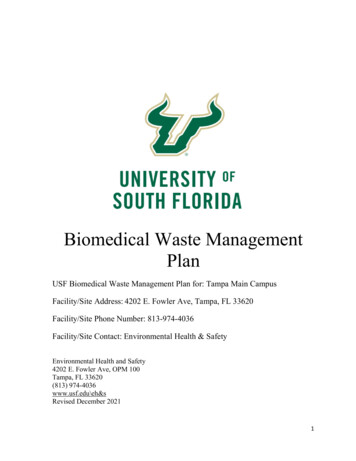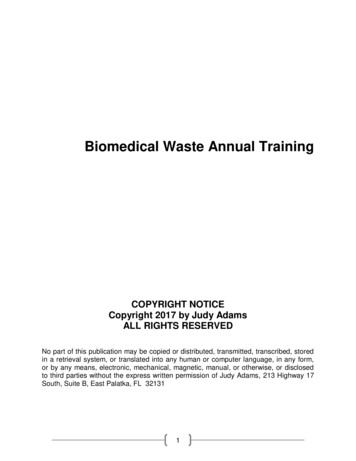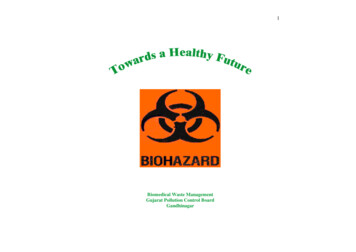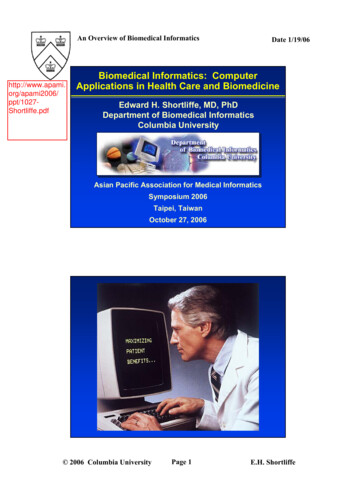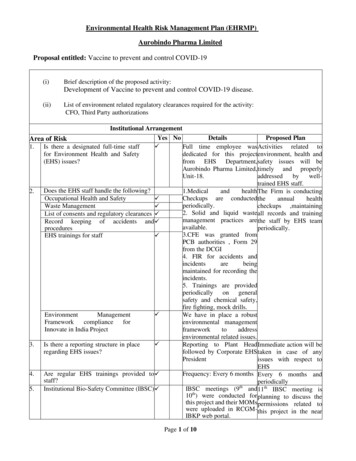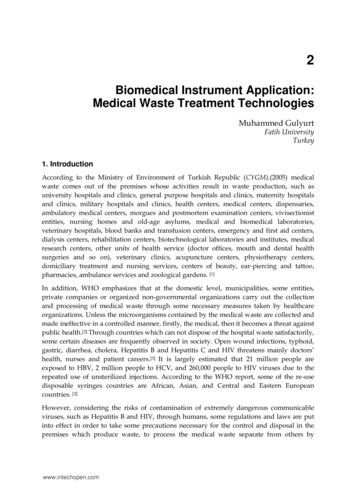
Transcription
2Biomedical Instrument Application:Medical Waste Treatment TechnologiesMuhammed GulyurtFatih UniversityTurkey1. IntroductionAccording to the Ministry of Environment of Turkish Republic (CYGM),(2005) medicalwaste comes out of the premises whose activities result in waste production, such asuniversity hospitals and clinics, general purpose hospitals and clinics, maternity hospitalsand clinics, military hospitals and clinics, health centers, medical centers, dispensaries,ambulatory medical centers, morgues and postmortem examination centers, vivisectionistentities, nursing homes and old-age asylums, medical and biomedical laboratories,veterinary hospitals, blood banks and transfusion centers, emergency and first aid centers,dialysis centers, rehabilitation centers, biotechnological laboratories and institutes, medicalresearch centers, other units of health service (doctor offices, mouth and dental healthsurgeries and so on), veterinary clinics, acupuncture centers, physiotherapy centers,domiciliary treatment and nursing services, centers of beauty, ear-piercing and tattoo,pharmacies, ambulance services and zoological gardens. [1]In addition, WHO emphasizes that at the domestic level, municipalities, some entities,private companies or organized non-governmental organizations carry out the collectionand processing of medical waste through some necessary measures taken by healthcareorganizations. Unless the microorganisms contained by the medical waste are collected andmade ineffective in a controlled manner, firstly, the medical, then it becomes a threat againstpublic health.[2] Through countries which can not dispose of the hospital waste satisfactorily,some certain diseases are frequently observed in society. Open wound infections, typhoid,gastric, diarrhea, cholera, Hepatitis B and Hepatitis C and HIV threatens mainly doctors’health, nurses and patient careers.[3] It is largely estimated that 21 million people areexposed to HBV, 2 million people to HCV, and 260,000 people to HIV viruses due to therepeated use of unsterilized injections. According to the WHO report, some of the re-usedisposable syringes countries are African, Asian, and Central and Eastern Europeancountries. [2]However, considering the risks of contamination of extremely dangerous communicableviruses, such as Hepatitis B and HIV, through humans, some regulations and laws are putinto effect in order to take some precautions necessary for the control and disposal in thepremises which produce waste, to process the medical waste separate from others bywww.intechopen.com
38A Roadmap of Biomedical Engineers and Milestonespreventing any harm against public health and environment. Those regulations describe theoverall procedure in a detailed way, from the identification of medical waste to its collectionand disposal.Moreover, European Union waste management strategy Council Directive 75/442/EEC, [4]dated 15 July 1975 was repealed on 5 April 2006; and it has been determined to theEuropean Parliament and Council Directive 2006/12/EEC, [5]. In the abovementioneddirective, there are some definitions of waste, and classifications of the waste categoriesincluded in the directive, and outlines of disposal and recycling activities. The appendix ofthe directive comprises some provisions which constitute the foundations and mainprinciples of the waste management regarding the waste types outside the coverage, generalprinciples with respect to the waste management, formation of the authorities, the wastemanagement plans, the liabilities of the enterprises which are involved in the recycling anddisposal activities, their obligation to hold records and their periodical auditing, the wastedisposal expenses covered within the scope of the polluter pays principle and producerresponsibilities.Furthermore, the Commission Resolution 2000/532/EC (2000)[6] underlined that theprinciples of compiling a common list for waste and hazardous waste to be used incommunity, in compliance both with Waste Framework Directive and the Council Directive91/689/EEC, [7] on the hazardous waste. The Waste Framework Directive and the directiveof waste list are both adopted by the member countries of European Union, andincorporated into “the directives to be primarily adjusted” [7] sections in the countries in theEuropean Union accession process, such as Turkey. While the regulations and laws vary atthe level of states in the USA, it is determined in some international congresses andseminars that they are one step ahead of the European countries.2. The historical background in the USAThe classification of medical waste was one of the most important questions in terms of theU.S. regulations during 1970s. Its officially first recognition as a distinct waste type wasprovided by a federal agency in 1978. EPA’s approach to the question was one step furtherin the sense that it principally described infectious waste, i.e. medical waste, under thecategory of hazardous waste in compliance with the Resource Conservation Recovery Act(RCRA). Thus, although the EPA’s proposition for hazardous waste regulations includesinfectious wastes as proclaimed in RCRA in 1980, the agency refused that medical wastesdid not constitute any serious threat to public health and environment.Looking at the implementations in European countries and the USA, it can be observed thatthere are numbers of systems of the medical waste disposal. Besides within the scope of thesterilization methods as the primary Medical Waste Treatment Technologies, there areoxygenic, ozonic and oxygen-free methods of disposing which are preferred in largeintegrated plants. Although burning is exactly a disposal method, it is not preferred by somecountries since a considerable amount of hazardous soot and ash comes out of the burningoperation. Expenditures seem to be important in the choice of Medical Waste TreatmentTechnology methods. Yet, the resolutions taken by the governments and the laws to whichthey are subjected are directing factors in their choices. The purpose of this chapter is toanalyse the analyze the Medical Waste Treatment Technologies.www.intechopen.com
Biomedical Instrument Application393. What are the hazardous medical wastesMedical waste is defined by the World Health Organization as “a broad range of materialssuch as used needles and syringes to soiled dressings, body parts, diagnostic samples,blood, chemicals, pharmaceuticals, medical devices and radioactive materials which areproduced health care clinics, centers, hospitals and laboratories.”[8]Through European Union Legislation 75/442/EEC [4] dated 15 July 1975 defines themeaning of “waste”, while the Council Directive describes “hazardous waste” in theEuropean Union Legislation 91/689/EEC [7] on 12 December 1991. Within the EuropeanUnion Legislations, the descriptions of the types of hazardous wastes, the precautions to bemade, the waste management, the transmission and disposal of hazardous wastes areavailable. The countries in the European Union accession process, on the other hand,exercise those regulations in the period grated in accordance with the course of the process.3.1 International biotechnology logoThe biohazard symbol which is associated with the term “biological hazards” simply meansthat it is extremely important to take precautions due to a potential exposition of thematerials threatening public heath. The Dow Chemical Company first designed the symbolfor their waste storages in 1966.[9]Fig. 1. Biohazard warning symbol. The sign color stipulated in the standard form isfluorescent orange-red. [9]3.2 What is the medical waste categories?The European Union Council Directive 67/548/EEC [10] was promulgated on 27 June 1967,with respect to the adjustment of laws, regulations and administrative provisions regardingthe classification, packaging and labeling of hazardous waste. Based on this directive, theMinistry of Environment and Forestry of Turkish Republic published “the Regulations forthe Medical Waste Control 25883” on July 22, 2005, [1] and c
Thus, although the EPA s proposition for hazardous waste regulations includes infectious wastes as proclaimed in RCRA in 1980, the agency refused that medical wastes . What are the hazardous medical wastes Medical waste is defined by the World Health Organization as a broad range of materials
